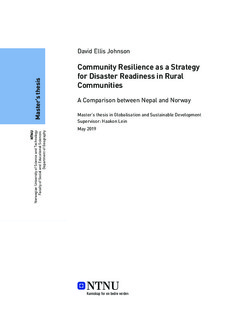| dc.description.abstract | There are many differences which become immediately evident when comparing rural communities in Nepal to those in Norway. On the surface it is easy to distinguish differences in culture, language, and levels of development between rural communities in the countries with less obvious differences in traditional practices and cooperation between community members becoming more obvious after closer examination. These differences have been driven by specific historical events and environmental factors unique to the region that these communities are situated in. However, despite their differences what is becoming ever more apparent are the similar challenges that these communities face as a consequence of global climate change. It is estimated that climate change will result in increased levels of annual precipitation as well as more frequent and longer periods of drought for communities in both Nepal and Norway. As a result, small rural and agrarian communities, whose livelihoods depend on the environment around them, will become more exposed to the effects of climate change. This paper examines how well equipped two communities in Nepal (Fulbari & Patalekhet) and Norway (Rissa and Byneset) are to deal with potential future environmentally hazardous events and how they can enhance their community resilience towards such events. Field observations and interviews with local community members in these areas were deemed to be very important assessment tools and were therefore carried out to gain a better understanding of how these communities operate and their overall level of preparedness towards these potential future environmentally hazardous events. This study focused specifically on three particular dimensions of resilience, them being social capital, community capacity and information & communication. The findings of this thesis indicate that out of the four studied communities Fulbari has the most limitations when it comes to preparing for climate change. The results indicate that an emphasise should be made to improve the sense of community with in the Fulbari community to further strengthen their resilience levels. Whilst in the two Norwegian communities the results from this study indicate that more effort should be made by local actors to share specific information about climate change relevant to these communities, and that community members should work together more to share information between themselves. | |
